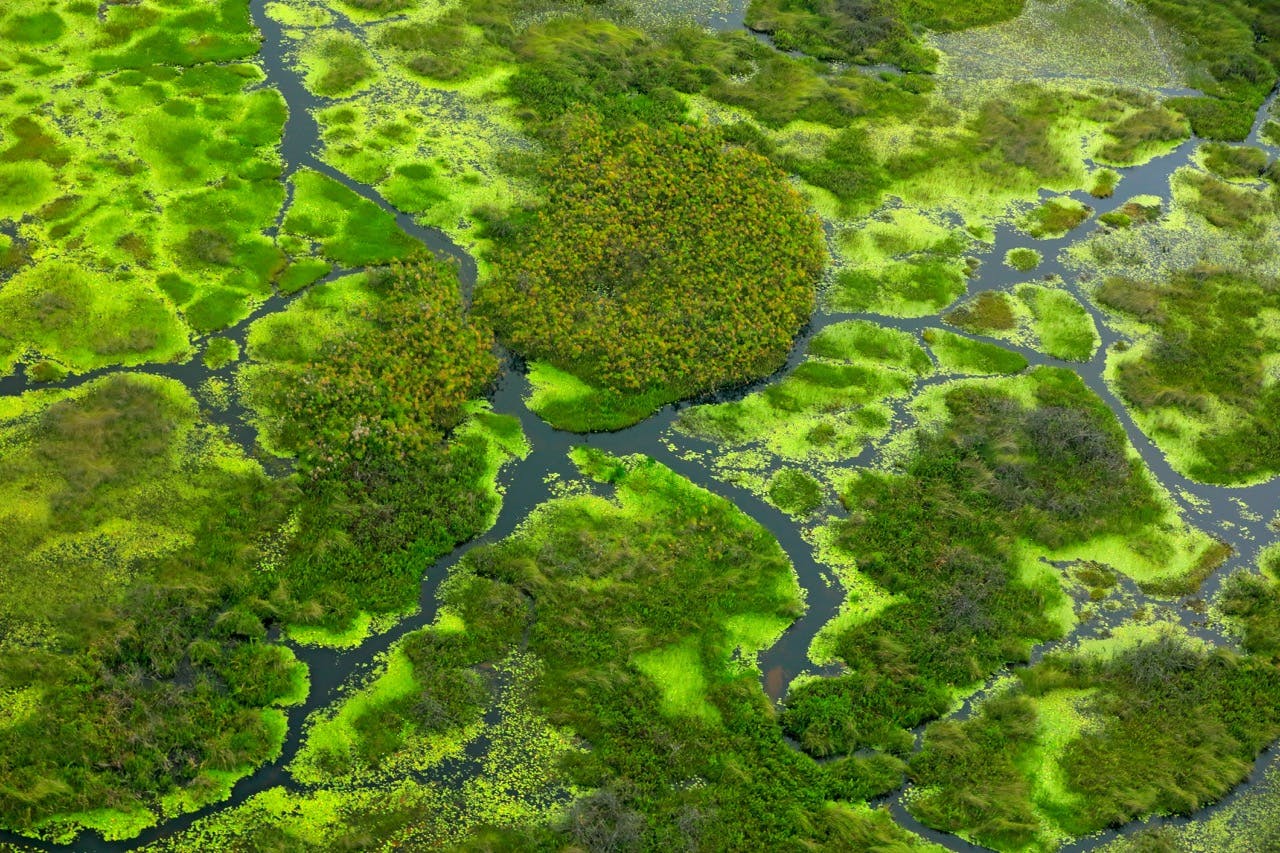We’ve grown accustomed to seeing the world divided into countries, states, and provinces, but there is another way to see and better understand the planet we call home. One Earth presents a novel biogeographical framework called Bioregions 2023, which delineates 185 discrete bioregions organized within the world's major biogeographical realms. The bioregions and the iconic species associated with each can be explored through One Earth’s Interactive Navigator.
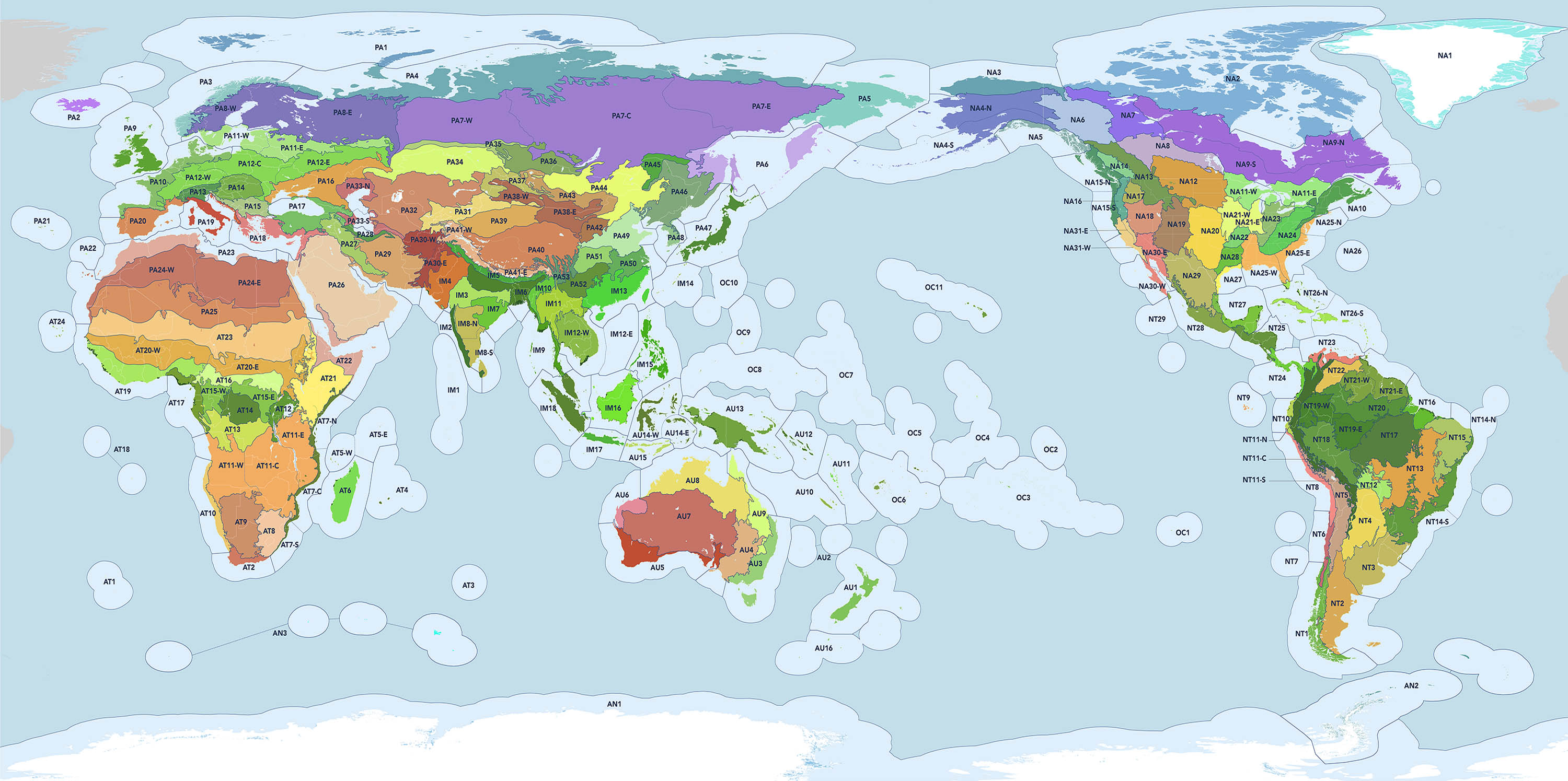
The One Earth Bioregions Framework: a new map of the Earth created by intersecting biomes with large-scale topographic features and ecoregional groupings to delineate 185 discrete bioregions. Download Map (6 MB). Image credit: Karl Burkart, One Earth
With input from an array of field scientists, conservation experts, and geographers, Bioregions 2023 provides a framework for collective action to protect and conserve our planet — from scientific research and governance initiatives to philanthropic grantmaking and public advocacy. It can also be useful as an educational tool, helping people better understand the underlying ecological fabric of life that surrounds them.
What is a bioregion?
A bioregion is a geographical area defined not by political boundaries but by ecological systems. A bioregion is considered to be generally smaller in scale than a biogeographical realm but larger than an ecoregion (Level IV). On land, the most widely held bioregional framework is the ‘biome’ (sometimes called an ‘ecozone’) -- a broad community of plants and animals adapted to specific climatic conditions found across a range of continents. There are 14 widely held biome types:
- Deserts & Xeric Shrublands (rust)
- Mountain Grasslands & Shrublands (beige)
- Temperate Grasslands, Savannas & Shrublands (yellow)
- Tropical & Subtropical Grasslands, Savannas & Shrublands (orange)
- Flooded Grasslands & Savannas (light blue)
- Mangroves (pink)
- Mediterranean Forests, Woodlands & Scrub (red)
- Temperate Broadleaf & Mixed Forests (dark green)
- Temperate Conifer Forests (grey-green)
- Tropical & Subtropical Coniferous Forests (light green)
- Tropical & Subtropical Dry Broadleaf Forests (olive green)
- Tropical & Subtropical Moist Broadleaf Forests (bright green)
- Boreal Forests/Taiga (medium blue)
- Tundra (teal)
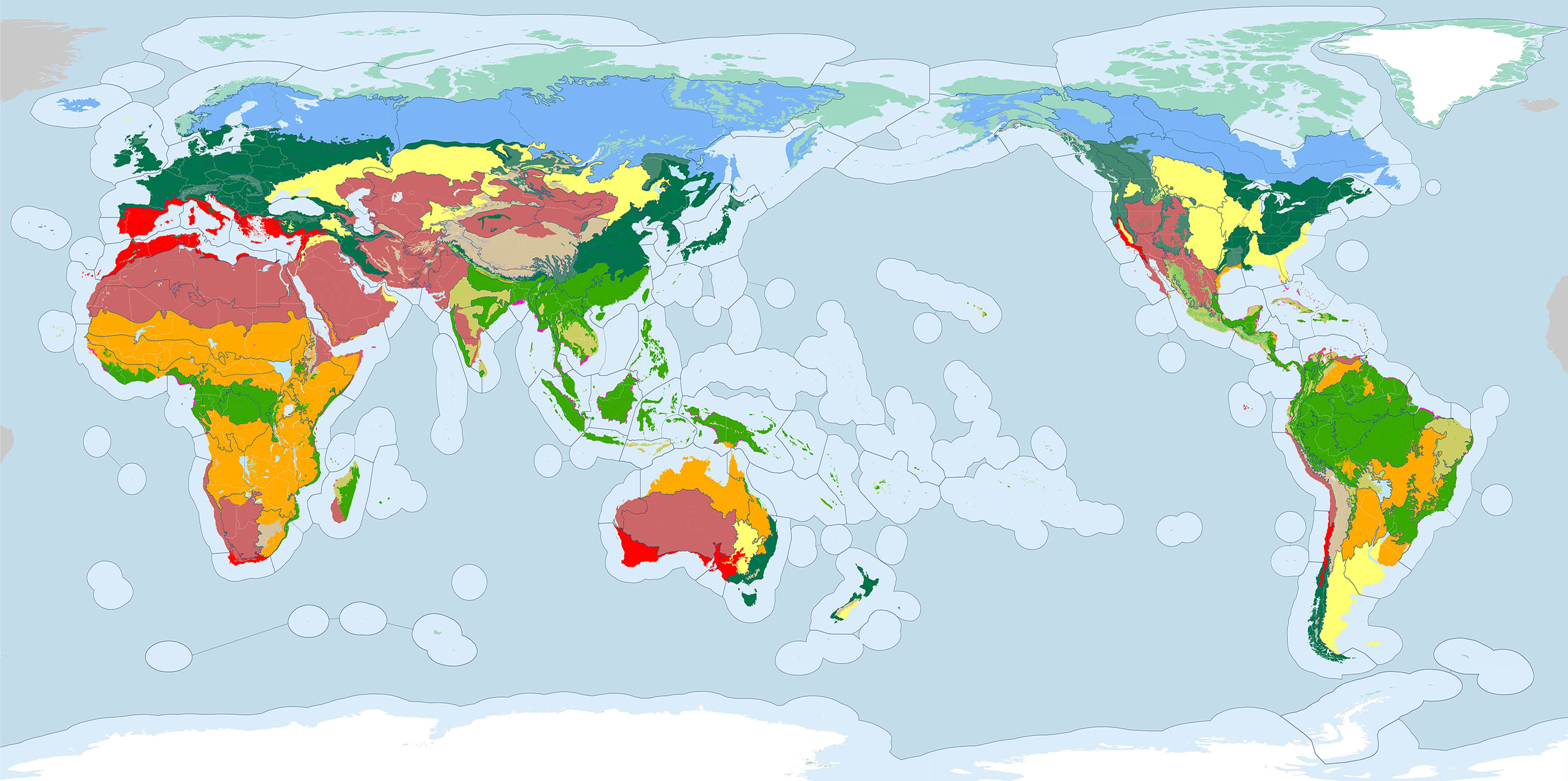
The Earth's 14 major biomes, which include six subtypes of the generic forest biome -- boreal, temperate broadleaf, temperate conifer, tropical moist broadleaf, tropical dry broadleaf, and tropical conifer. Biomes provide the highest order organizing principle used in the development of the One Earth Bioregions Framework. Download Map (6 MB). Image credit: Karl Burkart, One Earth
Biomes provide the highest-order organizing principle used in the development of One Earth’s Bioregions Framework. Conceptually, bioregions are major subdivisions of Earth’s biomes, contained within established realms and delineated by a process of intersecting biomes with large-scale geological structures -- mountain ranges, plains, plateaus, and basins – as well as commonly used climate zones. The bioregions incorporate adjoining freshwater and marine areas with an average land area of approximately 715,000 km2.
What is a realm?
The 185 bioregions are organized within the world’s major biogeographical ‘realms,’ the broadest division of the Earth's land surface within which groupings of organisms share a common evolutionary history -- Nearctic, Neotropic, Palearctic, Afrotropic, Indomalayan, Australasian, Oceanian, and Antarctic. The realms roughly correspond to the major continents of the Earth but are further subdivided to coincide with commonly held regional divisions. For example, the Neotropic realm is divided into “Central America” and “Southern America.” These realm divisions – 14 in total – are used as the overarching content framework for the One Earth website.
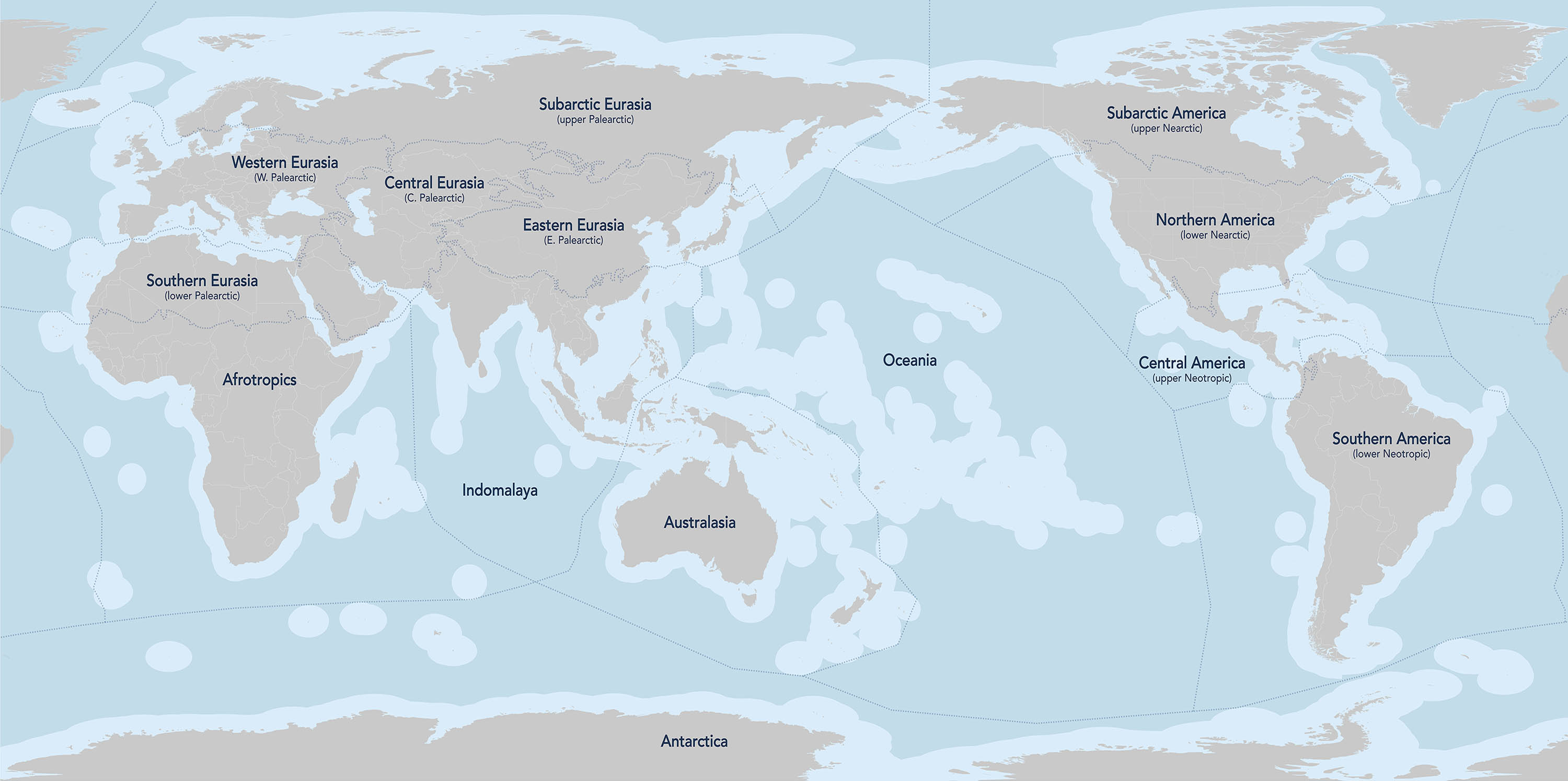
The 14 biogeographical realms of the Earth correspond with commonly held regional divisions. Between 3 and 24 bioregions are contained within each realm in the One Earth Bioregions Framework. Download Map (6 MB). Image credit: Karl Burkart, One Earth
Bioregions are fully nested within their parent realm, so each realm contains a finite number of bioregions, which can be further clustered into subrealms (defined below):
- Subarctic America (north Nearctic): 9 bioregions, 4 subrealms
- Northern America (greater Nearctic): 22 bioregions, 6 subrealms
- Central America & Caribbean (north Neotropic): 6 bioregions, 2 subrealms
- Southern America (greater Neotropic): 23 bioregions, 5 subrealms
- Subarctic Eurasia (north Palearctic): 8 bioregions, 4 subrealms
- Western Eurasia (west Palearctic, aka W. Europe): 13 bioregions, 5 subrealms
- Central Eurasia (central Palearctic, aka C. Asia): 11 bioregions, 5 subrealms
- Eastern Eurasia (east Palearctic, aka E. Asia): 16 bioregions, 6 subrealms
- Southern Eurasia (south Palearctic, aka MENA): 5 bioregions, 2 subrealms
- Afrotropics (aka Sub-Saharan Africa): 24 bioregions, 6 subrealms
- Indomalaya (aka South & Southeast Asia): 18 bioregions, 3 subrealms
- Australasia: 16 bioregions, 3 subrealms
- Oceania: 11 bioregions (not clustered)
- Antarctica: 3 bioregions (not clustered)
What is an ecoregion?
Ecoregions are the building blocks that make up each of One Earth's bioregions. Ecoregions are used to describe areas where ecosystems are generally similar, providing a spatial framework for the research, assessment, and monitoring of ecosystem functionality. There are several ways to define terrestrial ecoregions. The US Environmental Protection Agency uses an ecoregional framework developed in the 1980s by James Overnik with four nesting scales. Level I ecoregions are roughly comparable to what we now call “biomes.” Level II ecoregions are broad divisions of Level I, roughly equivalent in scale to One Earth’s bioregions. Level III ecoregions are an intermediate scale of ecological areas nested within Level II. Level IV ecoregions are much more detailed ecological units that most would refer to as ‘ecosystems’ nested within Level III.
An international consortium of conservation scientists recently released an updated map of the world’s terrestrial ecoregions in the paper “An Ecoregion-Based Approach to Protecting the Terrestrial Realm” (Dinerstein et al. 2017). This effort used recent advances in satellite imagery and remote sensing to identify 844 discreet ecoregions of the world (roughly equivalent to Level III ecoregions). These ecoregions provide the building blocks for Bioregions 2023. They are widely cited in scientific literature on conservation biology and frequently used for local-scale conservation planning efforts. The ecoregions can be explored through an interactive web application developed by RESOLVE and Google Earth Engine, with detailed ecoregion profiles provided by One Earth.
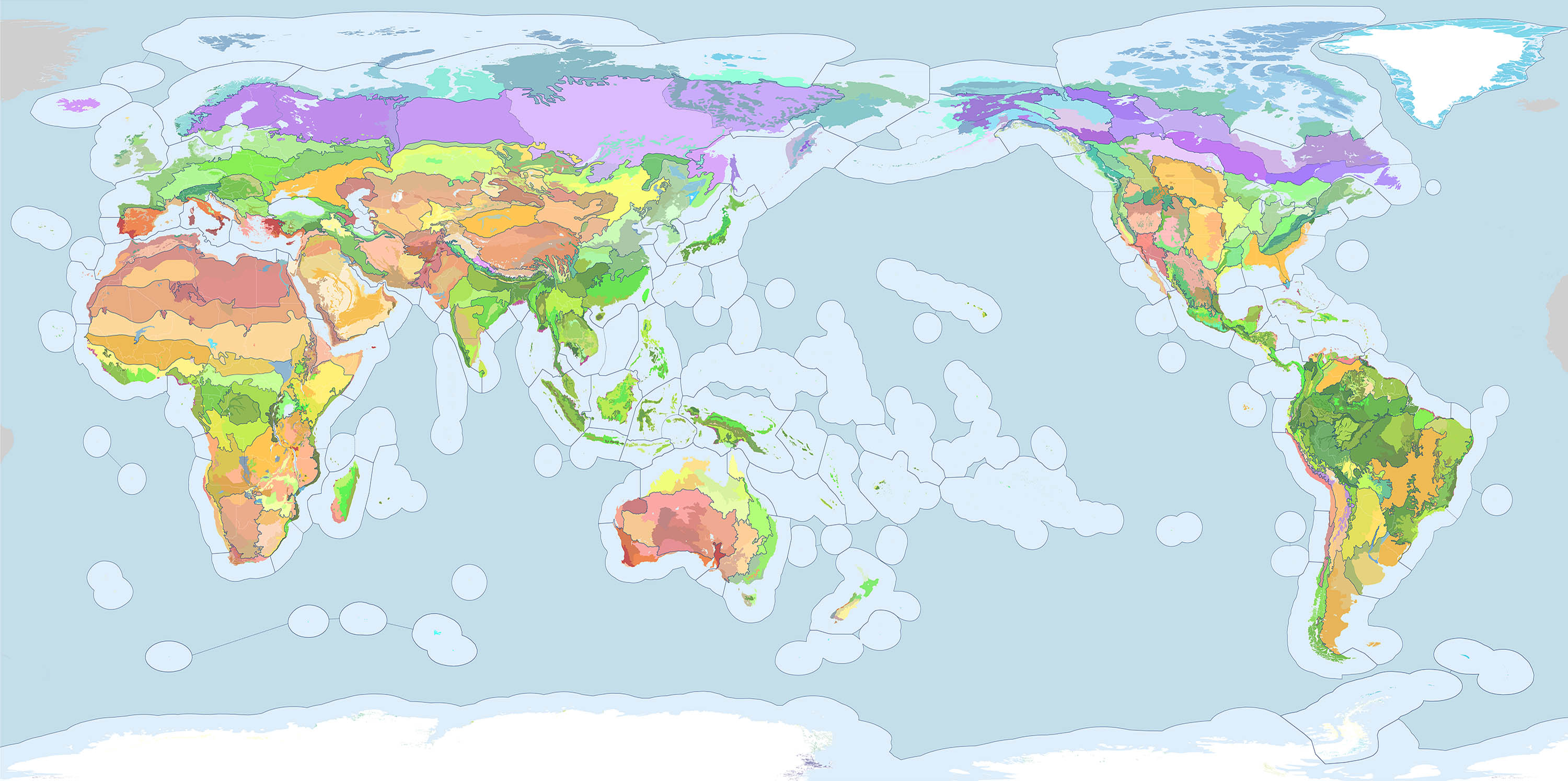
The 844 terrestrial ecoregions of the Earth (Dinerstein et al. 2017) overlayed with One Earth's Bioregions polygons. A finite number of ecoregions are nested within each bioregion. Download Map (6 MB). Image credit: Karl Burkart, One Earth
While the terrestrial ecoregions are a powerful geospatial framework for scientific efforts, they are often too small and too numerous to be readily adopted for the purposes of broader public engagement and resource allocation. In many cases, the spatial configuration of one ecoregion is embedded tightly within another and thus should not be considered apart, for example, when setting national conservation targets under the Kunming-Montreal Global Biodiversity Framework. One clear example of this is the Italian Peninsula, where Mediterranean Woodlands and Scrub dominate, but which also contains the Apennines forest ecoregion. In other cases, groups of similar ecoregions that are adjacent to each other, for example, the three northern grassland ecoregions just to the east of the Rockies, share similar attributes and thus, from a conservation perspective, could be considered in tandem. It is for this reason that One Earth undertook the development of the Bioregions Framework.
One major benefit of this bioregional framework is that it also allows for the integration of all three types of ecoregions – terrestrial, freshwater, and marine -- into one cohesive system. The portion of rivers, streams, lakes, and ponds that flow through a terrestrial ecoregion are included within the bioregion, and in some cases, a watershed’s footprint influences the grouping of overlapping terrestrial ecoregions. Similarly, bioregions with coastal edges are extended outward to a corresponding country’s Exclusive Economic Zone (EEZ) boundaries. While EEZs are administrative boundaries, not biological ones, they effectively provide an ecosystem constraint, as most fishing and industrial activities occur within EEZs. “Marine Ecoregions of the World” (Spalding et al. 2007) is a key reference for Bioregions 2023 and, in some cases, informs the clustering of terrestrial ecoregions.
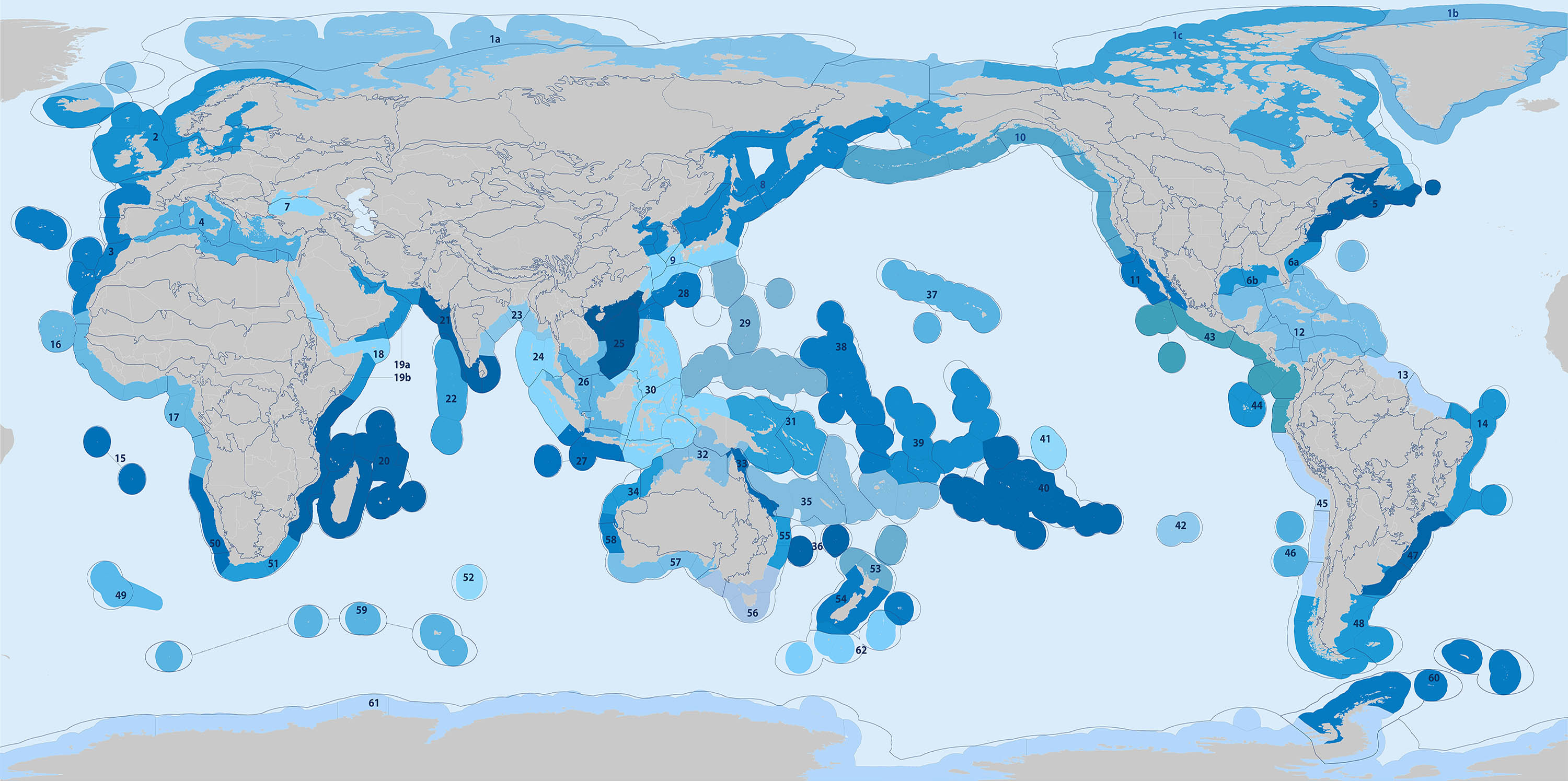
The 62 marine provinces from “Marine Ecoregions of the World” (Spalding et al. 2007) overlayed with One Earth's Bioregions polygons. Download Map (6 MB). Image credit: Karl Burkart, One Earth
The five rules used to define the One Earth bioregions
To establish the boundaries of each bioregion, a set of five rules was consistently applied across all realms, and specific scientific publications pertaining to each realm were referenced in order to align the bioregions as closely as possible with commonly held ecological divisions by continent. The top-level rules used in the development of the One Earth Bioregions Framework are as follows:
- Bioregions are contained within one of the 14 biogeographical realms (as defined above). A bioregion cannot cross over from one realm to another.
- Bioregions are predominantly subdivisions of the major biomes, defined by intersecting biomes with large-scale geological structures -- mountain ranges, plains, plateaus, and basins – and commonly used climate zones. An example of this is the great plains of the Midwest US, divided into three bioregions -- north, south, and central.
- Bioregions often consist of one biome type, but in some cases, ecoregions belonging to another biome are included when those ecoregions are embedded or closely interlinked with an adjoining ecoregion. An example of this is the Guianan savanna, which cannot be separated from the adjacent Guianan forests.
- Ecoregions are the building blocks of each bioregion. An ecoregion is never split between two bioregions (with the exception of mangroves, which often span across multiple bioregions).
- Bioregions include the marine areas beyond the coastline. These are demarcated using the EEZ boundary lines, as these waters are often heavily fished or experience impacts from activity on adjacent land areas. In some cases, marine provinces (Spalding et al. 2007) are used to articulate groupings of ecoregions within a bioregion.
The application of these five rules resulted in the delineation of 185 discreet ecological units that make up the Bioregions 2023 framework. The bioregions are built upward using ecoregions as building blocks but confined tightly within realms and major biome subdivisions. The bioregions incorporate adjoining freshwater and marine areas with an average land area of approximately 715,000 km2. There are 30 small island bioregions, the smallest being Bermuda, with only 39 km2 of land area (not including submerged coastal areas). The island bioregions are thus mainly delineated by their EEZ extents. The largest bioregion is the massive Siberian Boreal Forests & Mountain Tundra bioregion, which is 7.7 million km2 and divided into three large sections – west, central, and east.

One Earth Bioregions Framework by subrealm. Credit: Karl Burkart, One Earth
Defining the subrealms
With the full extent of each bioregion established, we can now group the 185 bioregions into subrealms -- intermediary divisions of the major realms that cluster bioregions into a more familiar geographical taxonomy. For example, the "Amazonia" subrealm is defined as a cluster of 5 tropical forest bioregions roughly coinciding with the Amazon River basin (note: some consider the Guianan tropical forests covering French Guiana, Suriname, and Guyana to be part of the Amazon region, but according to the Ecoregions 2017 framework they are not part of the Amazonian forest complex, possessing distinct flora and fauna and falling outside of the Amazon River watershed). Another example of a subrealm is the “Great Plains” region of North America, which groups together the three major grasslands bioregions covering the heartland of the US.
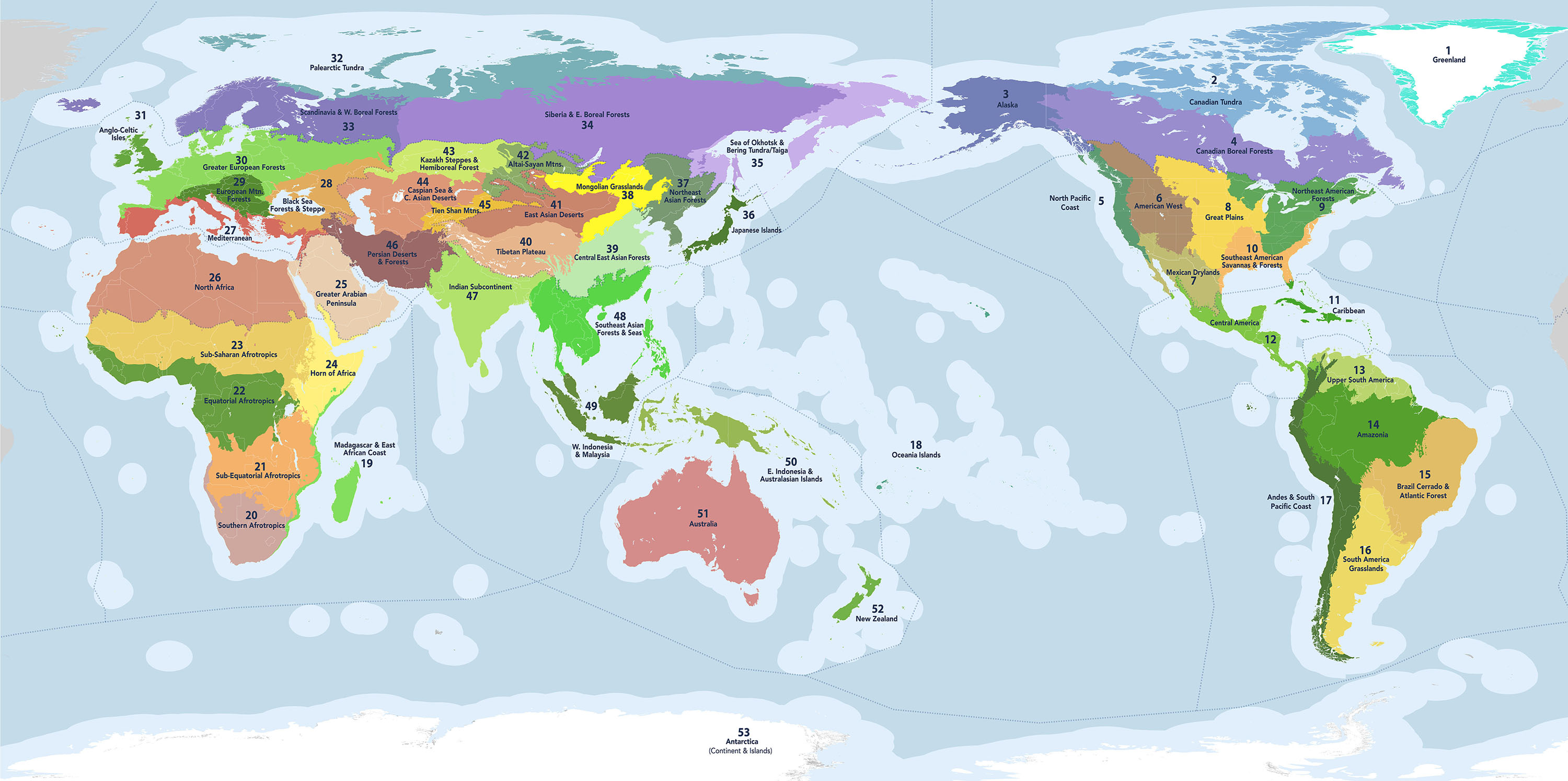
The 52 habitable subrealms of the One Earth Bioregions Framework. Download Map (2 MB). Image credit: Karl Burkart, One Earth
There are 52 habitable subrealms identified in the One Earth Bioregions Framework. Antarctica is designated as the 53rd subrealm, but it is only the coastal areas that are of interest for conservation. The High Seas (shown in slightly darker blue color) are not incorporated into the Bioregions Framework, though they are critical for marine conservation. Colors are generated from the dominant bioregions contained within each subrealm as follows:
- Subarctic America -- Greenland (cyan), Canadian Tundra (blue), Alaska (indigo), Canadian Boreal Forests (purple)
- Northern America -- North Pacific Coast (blue-green), American West (brown), Great Plains (gold), Northeast American Forests (green), Southeast US Savannas & Forests (orange), Mexican Drylands (olive)
- Central America & Caribbean -- Central America (light green), Caribbean (green)
- Southern America -- Upper South America (pale green), Amazonia (deep green), Brazil Cerrado & Atlantic Coast (tan), South American Grasslands (yellow), Andes Mountains & Pacific Coast (dark green)
- Oceania -- Oceanic Islands (green)
- Afrotropics -- Madagascar & East African Coast (bright green), Southern Afrotropics (rust), Sub-Equatorial Afrotropics (orange), Equatorial Afrotropics (emerald green), Sub-Saharan Afrotropics (tan), Horn of Africa (yellow)
- South Eurasia -- North Africa (red-orange), Greater Arabian Peninsula (beige)
- Western Eurasia -- Mediterranean (red), Black Sea Forests & Steppe (gold), European Mountain Forests (dark green), Greater European Forests (green), Anglo-Celtic Isles (emerald green)
- Subarctic Eurasia -- Palearctic Tundra (teal), Scandinavia & Western Boreal Forests (purple), Siberia & Eastern Boreal Forests (plum), Sea of Okhotsk & Bering Tundra/Taiga (lavender)
- Eastern Eurasia -- Japanese Islands (dark green), Northeast Asian Forests (grey-green), Mongolian Grasslands (yellow), Central East Asian Forests (pale green), Tibetan Plateau (tan), East Asian Deserts (red-brown)
- Central Eurasia -- Kazakh Steppes & Hemiboreal Forests (chartreuse), Caspian Sea & Central Asian Deserts (brown), Tien Shan Mountains (tan), Persian Deserts & Forests (dark red), Altai-Sayan Mountains (olive green)
- Indomalaya -- Indian Subcontinent (light green), Southeast Asian Forests (emerald green), Malaysia & Western Indonesia (dark green)
- Australasia -- Australasian Islands & Eastern Indonesia (olive green), Australia (red), New Zealand (green)
- Antarctica -- Antarctic Continent & Islands
You can explore each of the links above to learn more details about bioregion groupings within the 52 habitable subrealms, the unique characteristics of all 185 bioregions, and the plant and animal assemblages contained within each of the 844 component ecoregions that make up One Earth’s Bioregions Framework.
